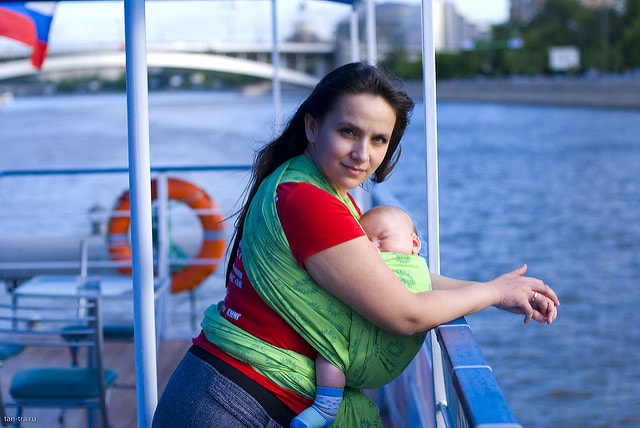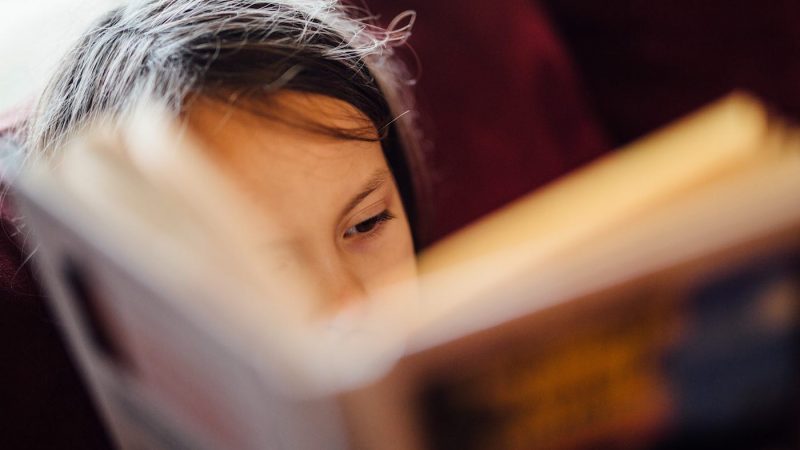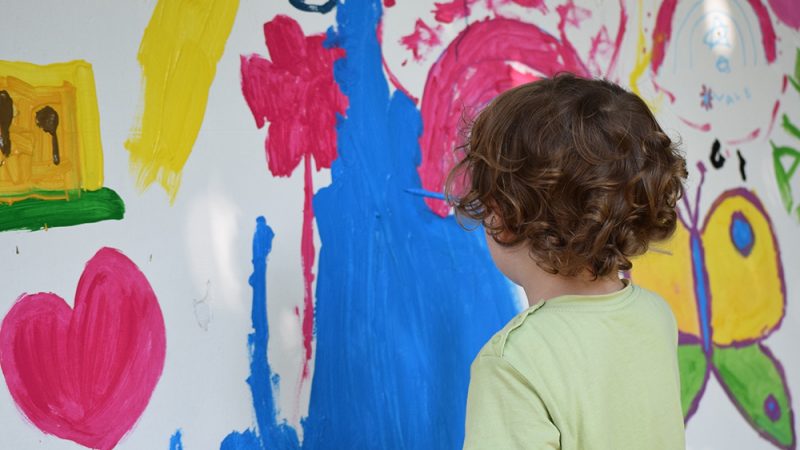
Baby on Board – a Q&A with Dr Rebecca Whittle on babywearing
Dr Rebecca Whittle is a human geographer at Lancaster University. She came to talk to us about her research into how babywearing affects people’s sense of space and place.
You can read about the background to her research in two blogs she has written:
Photo by Tatiana Vassina
Beccy: Hi everyone, lovely to meet you all.
I think some of you will already have seen the blogs about how I came to study this topic but, in a nutshell, the background is that I got really into slings whilst on maternity leave with my son (who is now 3.5) and, as a human geography lecturer, I could never quite switch off the work side of my brain which was telling me that this was also really interesting in terms of how we were both experiencing space, place and other people around us.
I thought “Oh, that’d make a fab research project someday”, but it took me 2 years after getting back to finally have the courage to ‘go for it’ and propose it as a serious project. I’m so glad I did though as it has been fascinating!
PSG B: What was the biggest surprise for you?
Beccy: I think maybe the biggest surprise was finding out that (admittedly from a very small sample), people seem to react differently to men and women carrying.
PSG C: That’s really interesting (if depressing).
Beccy: I agree. It would be interesting to speak to more men (as you can imagine, they were in a minority in my study) just to test that hunch out a bit more.
PSG C: There’s a dads with slings Facebook group (called something obvious along the lines of dads with slings!)
PSG D: I also imagine that many male partners of women who use slings are likely to too.
PSG E: Mine certainly did. I think he loved all the attention he got when he would take her around the supermarket in a sling!
PSG B: I think that people react differently to parenting in public in general, was it even more pronounced when it’s the father carrying in a sling?
Beccy: Sure – and I think a sling can obviously be interpreted by the wider public as a statement of your parenting philosophy in a way that can mark you out for comment – either positive or negative!
And of course the assumptions that people might make about you for carrying can be really inaccurate. For example, I interviewed several folks who didn’t fit what people might consider to be ‘the babywearing template’ in many different ways, so I think it is having a much wider appeal today than many people would assume.
But yes, the interesting thing about Dads seemed to be that no one made comments as if they were getting ‘too attached’ to their baby (as if that were possible or a bad thing!), whereas a woman doing the same would (sometimes) be questioned.
Beccy: Another key finding which was quite important, and surprising, was that, for many people the ‘crisis of mobility’ that we might expect to happen when someone has a baby, does not happen at all until the arrival of a second child – especially if there is quite a small age gap. A typical scenario here would be that mum has been happily using a pram for this time but now has a new child that needs pushing while the oldest isn’t old enough to leave the pram (and they don’t want to get a double buggy) so a sling can be fab here as you can carry one and push one and vary who gets to sit where!
Interestingly, several mums also said that using a sling with their newborn really helped minimise the impact on the older child from the arrival of a younger sibling. Since the newborn could be happy in the sling for much of the day, leaving you with hands and mind free to attend to your toddler and continue that relationship with them as you would have done previously.
That ability of a sling to maintain those family relationships with as little disruption as possible to anyone was really important to those mums, so I think this was a really great insight for me to have.
PSG A: Have you any thoughts on babywearing historically, and geography? I mean, prams/pushchairs are fairly recent technology. While slings have been around for thousands of years (if not longer). What has that meant for parents and their experiences of places?
Beccy: Great question! I’d love to do more on the history of this but could find surprisingly few resources (other than the book edited by Van Holt, “Beloved Burden”). So if anyone knows of anything I’d love to know about it!
Obviously the funny thing about slings now is that they are still viewed as novel/different compared to the mainstream of prams and car seats but, of course, carrying your baby (at least in some way, though not necessarily on your body) is as old as the hills, it would appear.
Rosie Knowles’ book (“Why Babywearing Matters“) also has some interesting things to say about this in terms of the physiology/evolution of early humans (and how necessary it was to be able to carry babies then). This isn’t my area but it was very interesting to read about.
PSG F: My sister in law is from Zimbabwe. Only rich people have a pushchair…..
PSG M: Are you aware of a difference in numbers of women who wear slings and breastfeed compared to those who choose not to breastfeed? I often assume those who wear slings are breastfeeding mothers but this may not be the case.
PSG E: I’ve noticed this too, but my sample is so small and biased (fellow mums I know) that it may not be a general thing.
Beccy: Great question. And yes, my sample was also small and there was a strong correlation between slings and (often ‘extended’) breastfeeding. However, again, what I think is lovely about babywearing – and there was a case in my study which supported this – is that it gives an additional option for bonding for those who can’t breastfeed.
And I think that is so important as I know mums can feel like they experience a lot of judgement and guilt if they can’t breastfeed. And of course, for Dads too, babywearing offers a fab way to get involved in baby’s life right from the word go.
I know this is a very emotive topic and I am a massive supporter of breastfeeding – and of course babywearing definitely helps breastfeeding – but I would worry if those who don’t breastfeed were put off using slings because they thought it was only something that breastfeeding mums did, if that makes sense?
PSG G: On a personal level I would have probably babyworn (if that’s the right term), but a couple of traits in my little girl meant that it was limited. Namely she didn’t like being restricted in a sling and would never transfer once asleep if I tried to get her out of the sling. Her temperament definitely defines some of the spaces I negotiated and methods of transportation.
The ability to test out slings must have a huge influence on the prevalence of baby carrying – but I guess this could be defined by both the physical place and virtual space i.e. there are loads of online groups for babywearing giving hints/suggestions.
Beccy: Great observation. Possibly controversial for my role as a babywearing peer supporter I know, (and repeating my caveat about a small study here!) but I definitely chatted to a couple of parents who wanted to carry more than they did but found that their child didn’t like it as much as they’d thought.
And yes, I know some people might say ‘well, you’ve just not found the right sling yet’, but in both cases, the parents had really tried to experiment with different kinds of slings and, for whatever reason, it just wasn’t working for the parent/child combo at that particular place and time.
So the children’s geographer in me says it’s also very important to acknowledge that children are very individual (as you say) and perhaps some don’t take to slings as readily as we might hope!
Though, as you say, having a library nearby with lots of stuff to try and lots of experienced helpers on hand with suggestions definitely increases the possibility of you finding something that works for you. Indeed, that was another very significant finding from my study was that it really is hugely individual what people find comfortable (and yes, I kind of knew that already but my experiences doing the research really reinforced this!).
PSG H: I agree, in my time helping with a sling library there were a couple of parents we just could not help because their babies didn’t like the sling.
PSG C: What did your research tell you about how children in slings and parents experience space and place?
Beccy: I’m currently struggling to describe this in 10,000 words for a journal article!! But I’ll try and share some highlights for you now…
One of the things that really struck me about the research was not just the practical benefits of babywearing (no more hassles with steps, cobbles, narrow doors etc), but the real desire on behalf of some parents to share particular places or experiences with their children in a way that would have been really tough with a pram.
For example, one parent loved walking in the hills and – both for her own sanity and out of a desire to share those experiences with her children – she really wanted them to be able to have those experiences (sharing those places and activities and, in so doing, sharing a part of herself that was deeply important with her child). She found that, if she stuck to ‘pram friendly’ walks she never got that sense of freedom., space and solitude that she craved.
And I think, as we’ve already discussed, there really is something very significant for the child about literally being able to look out at places and people literally from your point of view – somehow I think it’s a more direct and immediate way of you experiencing those things together.
PSG G: There’s also the protective (from others) element to baby wearing – holding them close so stop them being coo-ed/unwanted attention. The ability to breastfeed particularly on the move (although as you’ve already reported not a direct link between babywearing & breastfeeding)
PSG C: I’d totally agree with that, I felt much more like we were experiencing things together when I had my kids in slings.
I’d imagine it’s a much richer experience for the child as they not only experience the place and whatever is happening and also they will be aware of your reaction to it much more keenly than from a buggy.
Beccy: Absolutely. I think one of the interesting things I realised from the study is that there is one sense in which babywearing definitely allows you to keep them close and safe and protect them, and yourself, from unwanted attention (and the weather, etc!) especially when they are young and small. And yes, privacy over breastfeeding can also be a big part of that.
But I noticed there can also be a sense in which, at other times, babywearing can mark you out as very visible (as anyone who has ever attempted wrapping in public will testify!), so I think there’s an interesting paradox going on there, if that’s the right word?
PSG C: I imagine there’s a difference in that feeling of being “marked out” at different times of the year. I’m sure people noticed my spring born baby much more in summer, than they did my winter born baby. He was snuggled in the sling with my coat wrapped round him, much easier to miss he was there.
PSG G: Indeed – a definite duality and probably determined by your personality/confidence, how your little one is and the community that you find yourself in.
PSG I: Do you have plans for any further research in this area?
Beccy: My instinctive reaction is I would love to! But I guess I need to finish writing this one up properly and also get some funding:-(
But it would be lovely to hear from you guys if there are topics/questions in this area that you think would be useful/worthy of investigation. I so want this stuff to be useful to more than just me!
PSG J: I find this sort of research really fascinating, as it confirms that my experiences of babywearing are not unusual. But what other people (i.e. not us lay people) find this sort of research useful? How do you see it influencing (if you think that it could), and who might it influence?
Beccy: That’s a really great question and I feel I need to have a lot more of these conversations to really find that out. So again, suggestions would be really welcome!
When I first set out to do the research, it was partly because conversations with other babywearing professionals made me realise that part of what they felt was needed to make babywearing more mainstream was more research providing evidence of its benefits (so properly checking out and documenting all that stuff that we’ve all suspected for some time) and I guess that’s what I am setting out to do here in my own small way.
But I realise that, with my stuff, there isn’t perhaps as much of a direct ‘audience’ as there might be for a study on slings and hip health for example (paediatricians) or slings and bonding at birth (midwives) so I am struggling a bit with this question of ‘who needs to know this stuff’? I feel I am preaching a little to the converted at the moment! So suggestions welcome, folks!
PSG A: Was there any correlation between babywearing and fitness/activity levels? If babywearing had a positive effect on that, that would have public health implications.
And if the Scottish baby boxes increased babywearing levels, I bet the Scottish government would be very pleased to hear that!
Beccy: Yes there kind of was a connection between fitness levels and slings. Again, very small sample, but I had some very interesting examples of mums who felt that, contrary to what you might expect, slings were easier on their backs than a pram.
Also a tentative suggestion that slings make you more aware of your own body and its limitations, and how it is feeling from day to day, so perhaps this lends itself to you taking care of yourself better? But, as I say, this was a very small sample. But I find this idea of the connection between slings and body awareness fascinating…
PSG A: I just found I walked a lot more with a sling. Prams/buggies are so cumbersome.
Beccy: Yes, and interestingly I spoke to a dad who deliberately used the sling as a way to get exercise – he used to run a lot previously but found it hard to fit in with 2 young children, so the sling helped him feel like he was doing his best to stay fit.
PSG J: Off the top of my head, I wonder whether your research might be interesting to museum designers. I’ve been aware of people looking at how to increase their appeal to parents of young children, and as well as things to do with entertaining the children themselves, they did a lot of stuff about how buggies and prams affect parents’ interaction with exhibitions. I wonder how babywearing influences that sort of space……
PSG D: Is it also possible to look at sling use and groups? I’m thinking about the people you might learn to wrap a baby from – sling meets, family, cultural groups? And how important these might be in early motherhood?
Beccy: Absolutely – I think this is a key topic and it is actually something I’m contemplating writing my second article from the research on. So yes, there’s the whole importance of support/friendship available through babywearing groups and local libraries (though also some pretty horrendous stories of ‘drama’ from online groups, which is very sad, I think!). But, what I think is really interesting is that face-to-face support in terms of how you learn to sling and the sheer scale and pace of innovation that is coming from those communities. So there’s something fascinating here about how people learn to sling, I think…
PSG G: Yes how it also ties into different parenting groups/styles. Our LLL group has a natural affinity with baby wearing & particularly how it can help with issues such as colic/reflux.
PSG D: I think so. For example, there’s a large Afro-Caribbean community who live in SE London, and there’s clearly a wrapping style and skill passed on there, that is different to how I’ve been taught.
PSG G: Cultural variations and the investigating potentially why those differences might have arisen would be fascinating
Beccy: Great ideas ladies, thank you!
PSG K: I would love to know how the race of the baby wearer impacts how they engage (or are forced to engage) with the world around them. As a South Asian woman with a biracial child, I find a lot of hostility towards it (from random strangers or from those who think I am subjecting a white child to a non-Western practice) .
Beccy: That’s interesting and I’m sorry you’ve been experiencing hostility. Again, my sample is small so I don’t have enough evidence to offer general comments except to say that, yes, one of my interviewees did experience some racism in relation to carrying (I think some assumptions made by strangers about her wrapping because ‘that’s what you do in your native land, or something like that) and of course, she was from Manchester 🙁
So definitely more research needs to be done here but just to say that, from my very small study, it appears it isn’t just you that has experienced this, sadly.
PSG L: Did you find any correlation positive or negative between poverty and babywearing?
Beccy: Good question. I didn’t ask people specifically about income and didn’t have a large enough study to make that kind of call but what I will say is that I think it is a lot more complex than the ‘babywearing = middle class mum’ picture that we’re often presented with.
So yes, clearly some of the folks I spoke to were able to – or had chosen to – spend quite a bit of money on slings and prams but, equally, I had a couple of mums who had very little money – one of whom had deliberately chosen to babywear (with just 2 slings she owned) in order to save money (she had been given a pushchair second hand but couldn’t afford to buy a pram for a newborn so chose to use a sling – at first borrowed from the library instead).
And it was great to hear from one of my interviewees about the Scottish baby boxes scheme, which I gather is providing all parents with a free stretchy so that, in theory at least, everyone gets the chance to do this (though I know it’s not as simple as that)…
PSG L: I think the Scottish box scheme is amazing and it will be interesting to see how/if it affects levels of babywearing in Scotland and attitudes towards in.
Beccy: I agree. I don’t know much about it but would like to know more.
PSG O: I get lots of comments, especially from older people, about how snug and cosy my 10 month old looks in her sling. Are people more likely to start chatting to a baby-wearing parent? Or are babies in prams cooed over just the same? Or maybe I live in an area with very chatty OAPs? Is there any research into how different ways of transporting children is viewed by others?
Beccy: Great question! As far as I’m aware there has been some work in anthropology and history on how babies have been carried/transported in different cultures around the world throughout history (the book edited by Van Holt, ‘Beloved Burden’ is excellent for this).
But I think there’s very little on how people react to children being transported in different ways now (there are a few lovely articles – one of which I refer to in my blog about this – but there’s really not much at all, which was one reason I wanted to do this…).
Interestingly, the sling using parents in my study reported really diverse experiences, with almost everyone receiving positive comments from friends/family/strangers at some point (and many lovely comments from OAPs, as you say!).
However, on the whole it seems like people probably get less positive comments – and more questioning – as their baby gets bigger. So parents who carry toddlers (myself included) often find they have to explain their decision to carry a bit more (whereas a child of the same age in a pushchair probably wouldn’t be questioned in the same way). But this is not always the case – I still get nice comments carrying my 3.5 year old sometimes, and some others in my study experienced this too.
The really interesting thing I did discover was that, in my study men always got positive comments for babywearing – whatever the age of the child! (For example, men didn’t seem to get comments like ‘you’ll make that child clingy’ or some of the other critiques people can come out with) So I think there could well be some interesting gender issues here.
And yes, several parents noted that a child being carried at eye level will often get more interaction from people at the bus stop etc. purely because they are up there at adult level and part of the conversation, so to speak. Unless of course you have them on your back and then people reported comedy moments when the person you were speaking to didn’t realise you had a (massive!) toddler on your back.
PSG O: Thank you! I don’t carry my 3 year old much these days, but I’ve only had nice comments. The book you mention sounds really interesting – might have to try and find it somewhere to read.
Want to know more? Why not check our Beccy’s blog posts about her project:
You can find out more about human geography and the issues that researchers tackle in this interview with top geographer Doreen Massey by Social Science bites:
Or why not check out our Parenting Science Gang babywearing Q&A with Dr Rosie Knowles, What do we know about Babywearing?


